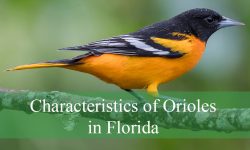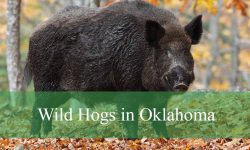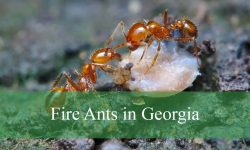Watching hummingbirds in Texas is one of my favorite outdoor pastimes. These tiny, jewel-like birds bring bursts of color and energy to gardens, parks, and wild spaces across the state. Each visit feels like a special moment, as they hover with incredible speed and grace, showing off their vibrant feathers and unique personalities.
Texas is home to an impressive variety of hummingbird species—19 to be exact—that can be spotted throughout the year depending on the season and location. From the familiar Ruby-throated to the rare Lucifer Hummingbird, each species offers a glimpse into the fascinating world of these tiny avian acrobats. Identifying them can be challenging but incredibly rewarding once you recognize their distinctive markings, colors, and behaviors.
Whether you’re a seasoned birder or just starting to appreciate hummingbirds, this guide will help you spot and identify all 19 hummingbird species found in Texas. Along with vivid photos and detailed descriptions, you’ll learn where and when to find these dazzling birds and enjoy the thrill of observing their amazing flight and feeding habits up close.
Common Hummingbirds Found in Texas
Ruby-throated Hummingbird

The Ruby-throated Hummingbird is one of the most recognizable hummingbirds in Texas, especially in the eastern part of the state. Males display a shimmering ruby-red throat patch, known as a gorget, that appears bright in direct sunlight but can look dark in shade. Females lack this red coloring, instead showing a white throat and greenish upperparts. Both sexes have slender, slightly downcurved bills adapted for sipping nectar, along with iridescent green backs and small, compact bodies. Adults measure about 3 to 3.5 inches long with a wingspan of roughly 4 inches, making them petite yet highly energetic.
These hummingbirds are primarily summer visitors to Texas, arriving in the spring and departing by early fall. They are often seen hovering near flowers or darting to feeders, where they consume sugar water as a supplement to their diet of nectar and small insects. Ruby-throated Hummingbirds are known for their rapid wingbeats, which can reach up to 53 per second, and their ability to fly not only forward but also backward and upside down for brief moments. Males are territorial and will fiercely chase away rivals from feeding areas.
A fun fact about the Ruby-throated Hummingbird is its incredible migration journey. Despite its tiny size, it can travel over 1,200 miles from breeding grounds in the United States to wintering areas in Central America. This includes a non-stop flight of up to 500 miles over the Gulf of Mexico, a remarkable feat of endurance and navigation for such a small bird. In Texas, they are often most abundant during migration, when gardens and feeders can attract dozens at once.
Black-chinned Hummingbird
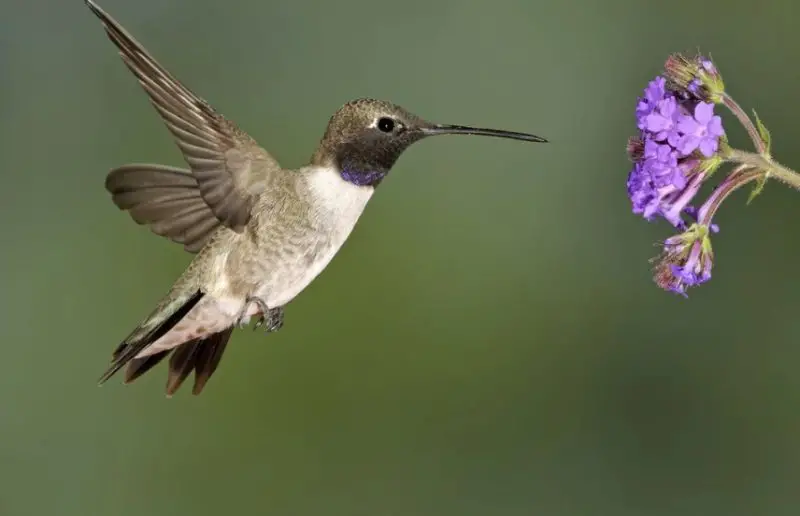
The Black-chinned Hummingbird is a common hummingbird species across much of Texas, particularly in the central and western regions. Adult males have an iridescent black throat that reveals a narrow violet band at the base when viewed in the right light. Females lack the dark throat, instead showing pale underparts and a faintly streaked throat. Both sexes have metallic green backs, slender bodies, and long, straight bills ideal for probing flowers. These hummingbirds typically measure between 3.25 and 3.5 inches in length with a wingspan of about 4.25 inches.
In Texas, Black-chinned Hummingbirds breed in a variety of habitats, including open woodlands, riparian corridors, and suburban gardens. They are adaptable and can thrive near human settlements if food sources like native flowers or feeders are available. Males perform distinctive display dives during courtship, producing a sharp sound with their wing feathers. Their diet consists of nectar from tubular flowers, supplemented with small insects and spiders, which provide essential protein.
A fun fact about the Black-chinned Hummingbird is that it can remember the exact locations of individual flowers and feeders along its feeding route. Some individuals return to the same breeding territory year after year, often to the very same perch. In Texas, these birds are often among the earliest arrivals in spring and can be seen well into late summer before migrating to Mexico for the winter.
Anna’s Hummingbird
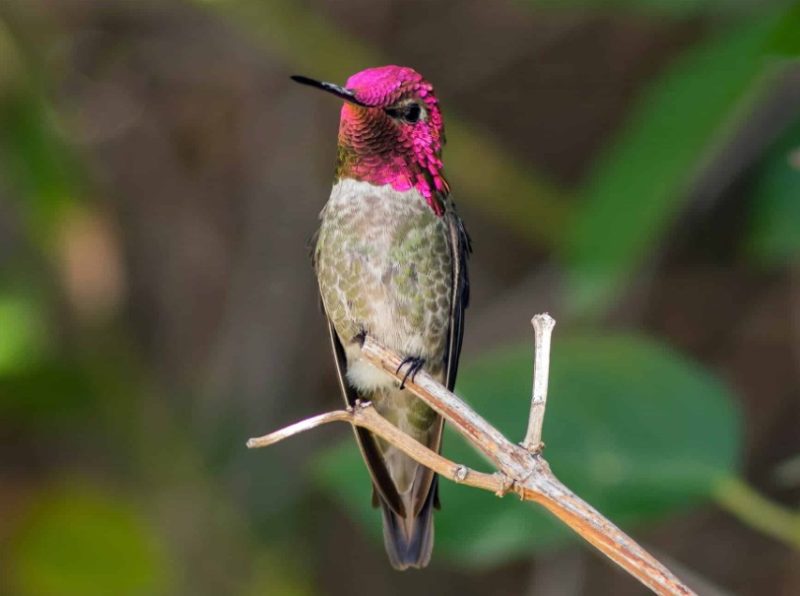
Anna’s Hummingbird is a striking species occasionally found in Texas, mainly in the western part of the state during migration or winter. Males are particularly eye-catching, with iridescent emerald-green plumage and a vivid pinkish-red crown and throat that glows brilliantly in sunlight. Females are generally duller, with greenish backs, grayish underparts, and some red spotting on the throat. These birds are slightly larger than many other hummingbirds in Texas, measuring about 3.9 to 4.3 inches long with a wingspan close to 4.7 inches.
Unlike most hummingbird species that migrate long distances, Anna’s Hummingbirds are known for their year-round presence along parts of the Pacific Coast. In Texas, sightings are less common, but they are occasionally spotted at well-stocked feeders, especially in the cooler months. They feed on nectar from a variety of flowers, but also actively hunt small insects midair or pluck them from spider webs. Males perform elaborate aerial displays, climbing high into the air before diving steeply with an audible “pop” made by their tail feathers.
A fun fact about Anna’s Hummingbird is that it can survive in surprisingly cold temperatures for a hummingbird, partly by entering a torpid state at night to conserve energy. Their iridescent gorget can appear different colors depending on the angle of light, sometimes flashing bright fuchsia or deep crimson. While they are not a widespread resident in Texas, their rare appearances always excite birdwatchers.
Rufous Hummingbird
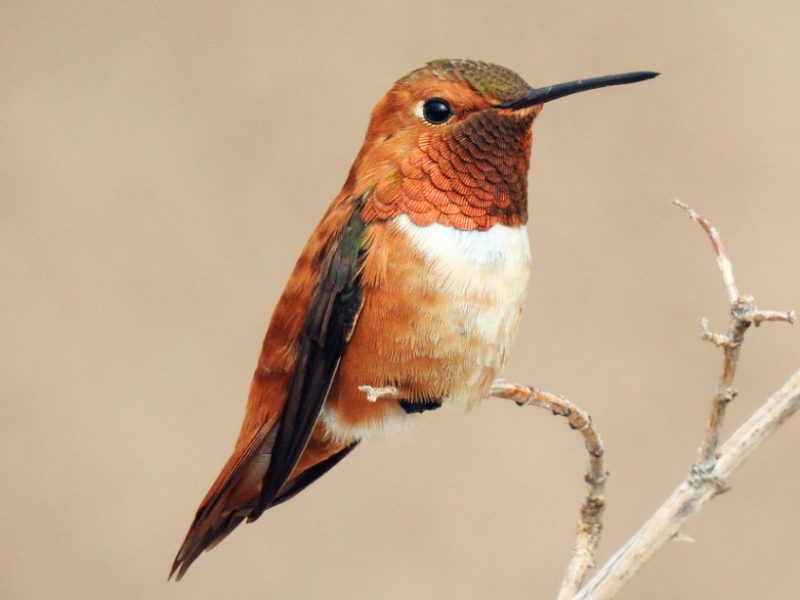
The Rufous Hummingbird is known for its bold coloration and aggressive personality, making it a memorable sight in Texas during migration. Males have bright orange-red bodies, an iridescent red throat, and white chests, while females are green above with rufous flanks and tail feathers. This species is slightly smaller than the Anna’s, averaging about 3.5 inches in length with a wingspan of around 4.3 inches. Their sturdy, compact build and rapid wingbeats give them an almost fiery presence in flight.
In Texas, Rufous Hummingbirds are most often seen during their long migratory journey between breeding grounds in the Pacific Northwest and Alaska, and wintering grounds in Mexico. They are frequent visitors to feeders, often dominating feeding stations and chasing away other hummingbirds. Their diet is rich in nectar, but they also catch small insects and gnats for protein. This species is famous for its remarkable endurance and ability to navigate vast distances.
A fun fact about Rufous Hummingbirds is that they hold the record for the longest migration relative to body size of any bird in the world. Some individuals travel more than 3,900 miles one way. In Texas, birdwatchers often spot them during late summer and early fall migration, when they can be surprisingly fearless, even approaching humans who are near feeders.
Broad-tailed Hummingbird
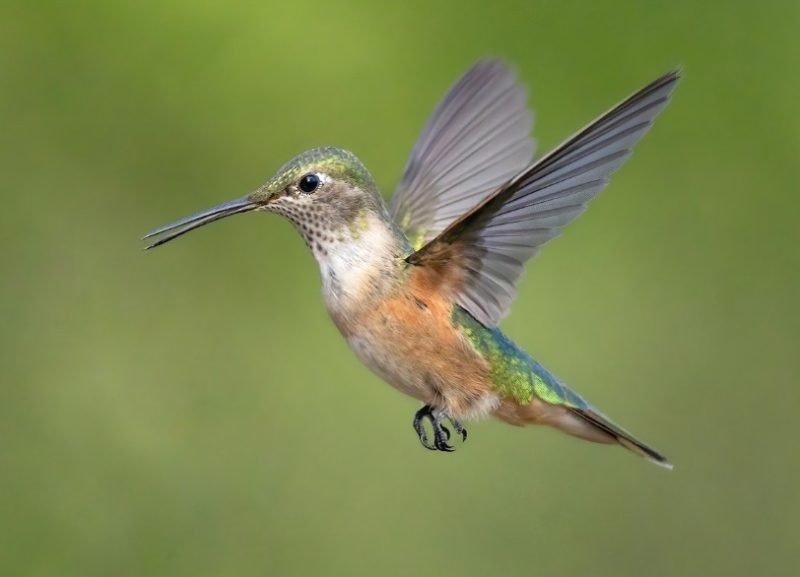
The Broad-tailed Hummingbird is a medium-sized hummingbird found in Texas primarily during the breeding season in the western highlands. Males are striking with a rosy-red throat, green back, and white underparts, while females have green upperparts and pale underparts with buffy flanks. Their most distinctive feature is their long, broad tail, edged with white in females and young birds. Adults typically measure 3.75 to 4 inches in length with a wingspan of about 5.25 inches, making them slightly larger than many other hummingbirds in the state.
This species prefers mountain meadows, open woodlands, and high-elevation areas in Texas, especially in the Davis and Guadalupe Mountains. Their rapid, insect-like wingbeats produce a distinctive trilling sound in flight, particularly noticeable in males. Broad-tailed Hummingbirds feed on nectar from native flowers like penstemon and columbine, as well as on small insects caught midair or gleaned from foliage. During courtship, males perform U-shaped flight displays to attract females.
A fun fact about Broad-tailed Hummingbirds is that they can tolerate chilly nights in high-altitude environments by lowering their body temperature in a state of torpor, conserving energy until sunrise. In Texas, they are often seen in late spring and summer before migrating southward in early fall. Their characteristic wing trill is often the first clue birders use to identify them before they come into view.
Calliope Hummingbird
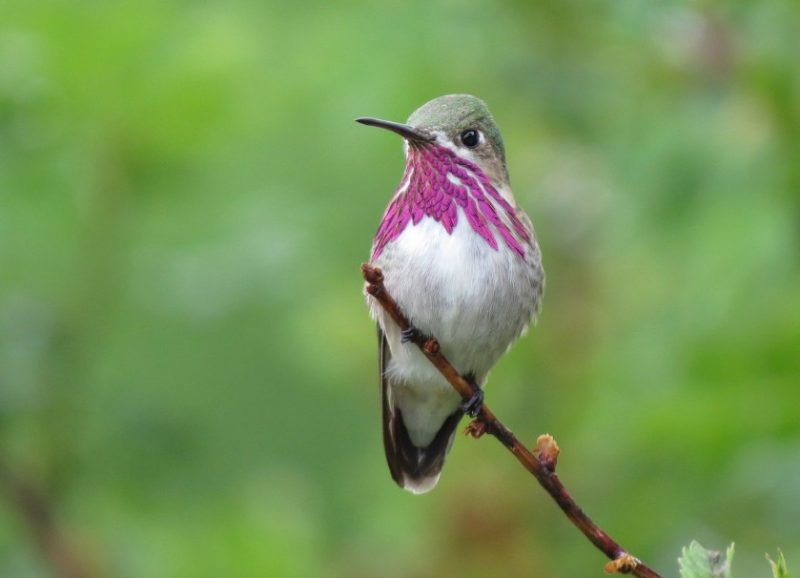
The Calliope Hummingbird is the smallest long-distance migratory bird in the world and a rare but fascinating visitor to Texas. Measuring only about 3 inches in length with a wingspan of 4.1 inches, it is noticeably petite even compared to other hummingbirds. Males are easily recognized by their dazzling magenta streaks that fan out from the throat, forming a distinctive starburst pattern, while females have green backs, white underparts, and buffy sides. Their delicate build and short, straight bills make them look particularly dainty at feeders.
In Texas, Calliope Hummingbirds are primarily seen during migration, especially in the fall when they pass through on their way to wintering grounds in Mexico. They prefer open woodlands, mountain meadows, and gardens with abundant nectar sources. Despite their tiny size, males are surprisingly territorial, chasing off larger hummingbirds from favored flowers and feeders. Their diet consists mainly of nectar, but they also hunt small insects to provide protein, especially during breeding and migration.
A fun fact about the Calliope Hummingbird is that it travels over 5,000 miles round trip during migration, making it the smallest bird to undertake such a lengthy journey. In Texas, lucky birdwatchers often spot them in late summer and early fall, when their small size and unique gorget pattern make them stand out among other migrating species.
Costa’s Hummingbird
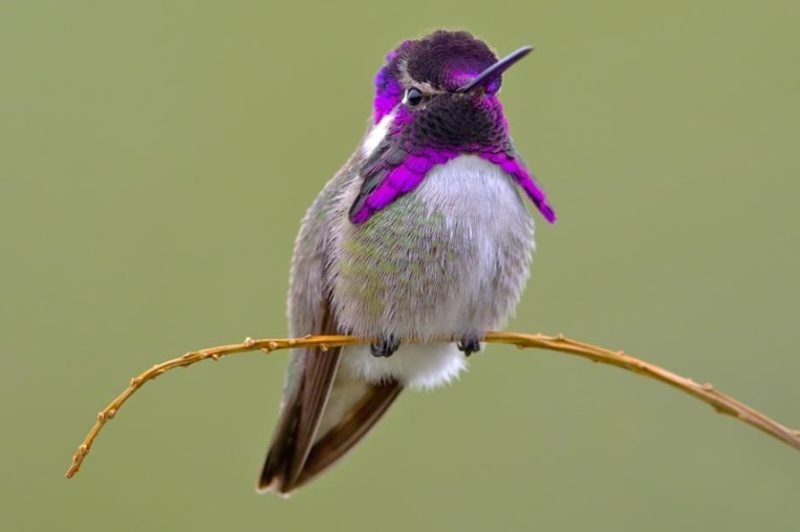
The Costa’s Hummingbird is a striking species occasionally found in Texas, particularly in the western deserts and during migration. Males are instantly recognizable by their deep violet crown and gorget, which extends into long, flaring “moustache” feathers on the sides of the head. Females are more subdued, with greenish backs and pale underparts, lacking the vivid purple markings. Adults measure about 3.5 inches long with a wingspan of approximately 4.3 inches, making them similar in size to the Black-chinned Hummingbird.
In their typical range, Costa’s Hummingbirds inhabit arid scrublands and desert washes, relying on desert-adapted flowers like ocotillo and chuparosa for nectar. In Texas, they are rare visitors, most often spotted in the far western regions. Males perform elaborate courtship displays, including U-shaped dives and a high-pitched, whistling flight sound produced by their wings. They feed on nectar and small insects, showing remarkable agility as they hover and dart between blossoms.
A fun fact about Costa’s Hummingbird is that their violet gorget feathers can appear almost black until hit by sunlight, at which point they flash an electric purple glow. In Texas, sightings are highly prized by birders, as they are one of the less common hummingbird species to pass through the state.
Buff-bellied Hummingbird

The Buff-bellied Hummingbird is a distinctive species found mainly in South Texas, especially near the Gulf Coast. Adults are slightly larger than many other hummingbirds in the region, measuring about 3.9 to 4.3 inches in length with a wingspan around 5 inches. They are easily identified by their metallic green upperparts, cinnamon-buff underparts, and long, slightly curved bills that are reddish with a black tip. The tail is often rufous-colored and slightly rounded.
This species is a year-round resident in parts of South Texas, thriving in coastal woodlands, brushlands, and gardens. They are known to be more tolerant of cooler temperatures than many other hummingbirds. Buff-bellied Hummingbirds feed on nectar from native flowers and feeders, but also actively chase away other hummingbirds from their territory. They supplement their diet with insects and spiders, which provide essential protein, especially during breeding.
A fun fact about the Buff-bellied Hummingbird is that unlike most hummingbirds in the United States, many individuals migrate north in late summer to breed before heading south again for the winter. In Texas, they can be seen year-round in some areas, with peak activity in the fall when they are particularly aggressive at feeders.
White-eared Hummingbird

The White-eared Hummingbird is a rare visitor to Texas, primarily found in the southwestern parts of the state during migration. It measures around 3.5 to 4 inches in length, with a wingspan close to 4.5 inches. Males have a dark green back, a white patch behind the eye which gives the species its name, and a deep rose-pink throat patch. Females are less conspicuous, showing green upperparts and a pale throat without the bright coloration. Their bills are slightly curved and adapted for accessing nectar deep within flowers.
White-eared Hummingbirds inhabit dry, mountainous areas with dense shrubs and flowering plants. In Texas, they are most often recorded in late spring or early fall during migration. Their diet consists mainly of nectar, but they supplement it with small insects caught on the wing or picked from foliage. Males are known for their territorial behavior, defending rich feeding territories vigorously from other hummingbirds.
A fun fact about the White-eared Hummingbird is that it shares a close evolutionary relationship with the closely named White-throated Hummingbird, but they differ in subtle plumage and vocalizations. In Texas, their rarity makes any sighting an exciting event for birders and hummingbird enthusiasts.
Green-tailed Hummingbird

The Green-tailed Hummingbird is a small, inconspicuous species occasionally observed in western Texas during migration. Adults measure about 3.25 inches long with a wingspan near 4 inches. Males have a distinctive green tail with broad white tips and a bright red throat patch, while females and juveniles display duller green upperparts and white underparts with some faint spotting. Their slender, slightly curved bills enable them to feed efficiently on a variety of desert flowers.
In Texas, Green-tailed Hummingbirds prefer dry, brushy habitats, often near rocky slopes and canyons where native flowers bloom. They are seen mostly during spring and fall migrations as they travel between breeding areas in the southwestern United States and wintering grounds further south. Their behavior includes rapid, darting flights and territorial displays by males defending feeding sites from intruders.
A fun fact about the Green-tailed Hummingbird is its remarkable adaptability to high desert environments, where it can endure significant temperature swings. Their subtle coloration helps them blend into shrubby surroundings, making them less conspicuous than more colorful hummingbird species.
Stripe-throated Hermit
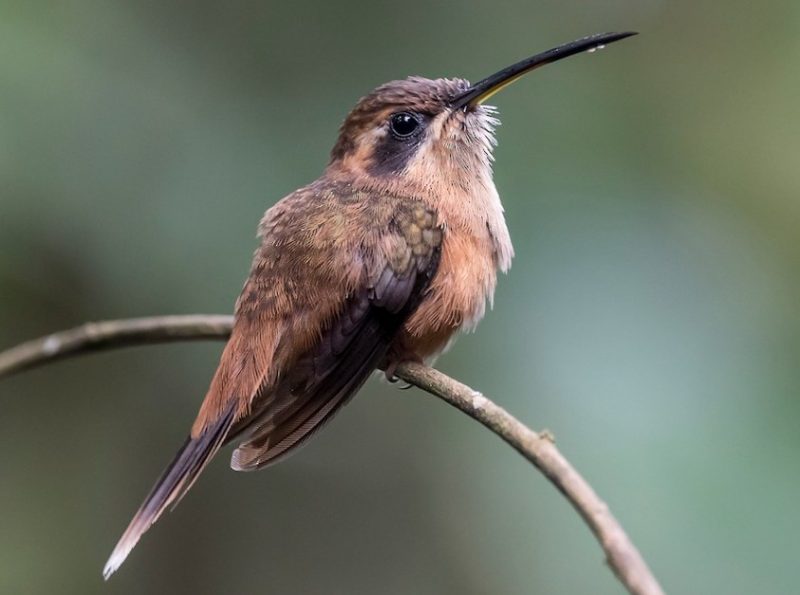
The Stripe-throated Hermit is a small hummingbird typically found in Central America but occasionally spotted as a rare vagrant in southern Texas. It measures about 3.1 inches in length and is identified by its distinctive striped throat pattern, brownish upperparts, and pale underparts. Its bill is slightly curved downward, perfect for feeding on tubular flowers.
This species favors forest edges and dense understory habitats where it feeds on nectar and small insects. Although sightings in Texas are very rare, they occasionally appear during migration or when displaced by storms. Their quiet, secretive behavior makes them easy to miss despite their bright markings.
A fun fact about the Stripe-throated Hermit is that it often uses a “trap-line” feeding strategy, visiting a sequence of flowers in a fixed route to maximize nectar intake efficiently. This behavior contrasts with more territorial hummingbirds that defend single feeding spots aggressively.
Green Violetear
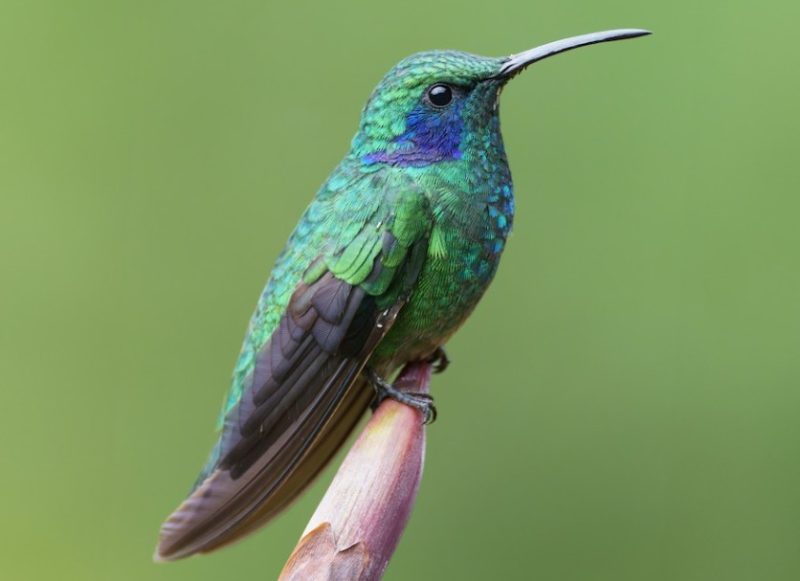
The Green Violetear is a large and striking hummingbird native to mountainous regions of Mexico and Central America. Measuring around 4 inches long with a wingspan of about 5 inches, it is one of the largest hummingbirds that can occasionally stray into southwestern Texas. Its vibrant green plumage and violet ear patches make it easy to identify.
In Texas, sightings are rare and usually linked to unusual dispersal events. The Green Violetear prefers pine-oak forests and high-elevation habitats, feeding on nectar from large tubular flowers and hunting insects. Its size and vivid colors make it stand out among other hummingbirds.
A fun fact about the Green Violetear is its ability to hover with remarkable stability, allowing it to feed on flowers in windy mountain environments. It also produces a distinctive buzzy wing sound during flight.
Violet-crowned Woodnymph (Rare Vagrant)
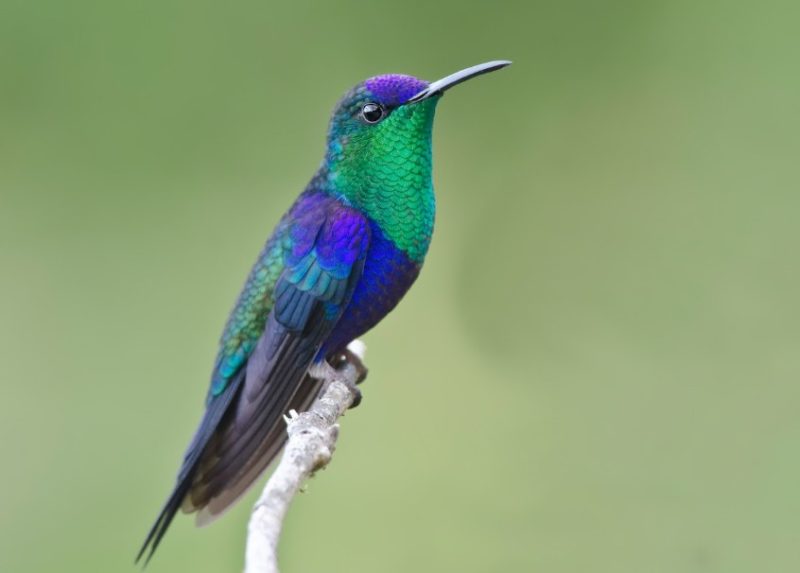
Though not a typical Texas resident, the Violet-crowned Woodnymph has been recorded as a rare vagrant in the far southern tip of Texas. It is a medium-sized hummingbird, measuring approximately 4 inches in length with a wingspan around 5 inches. Males are stunning with deep violet crowns, shimmering green backs, and white underparts, while females are duller but retain the distinctive violet crown and green upperparts. Their relatively long bills allow them to feed on deep tubular flowers found in subtropical environments.
In Texas, sightings of the Violet-crowned Woodnymph are exceptionally rare and usually occur during unusual migration events or storms that displace birds from their usual Central American range. They favor tropical forests and well-vegetated river valleys in their typical habitat but may be attracted to gardens with abundant nectar sources when appearing in Texas.
A fun fact about this species is that despite their rarity in Texas, Violet-crowned Woodnymphs are fairly common further south in Mexico and Central America, where they play a key role in pollinating native flowering plants. Their sudden appearance in Texas is a thrilling surprise for local birders and hummingbird watchers.
White-tailed Hummingbird
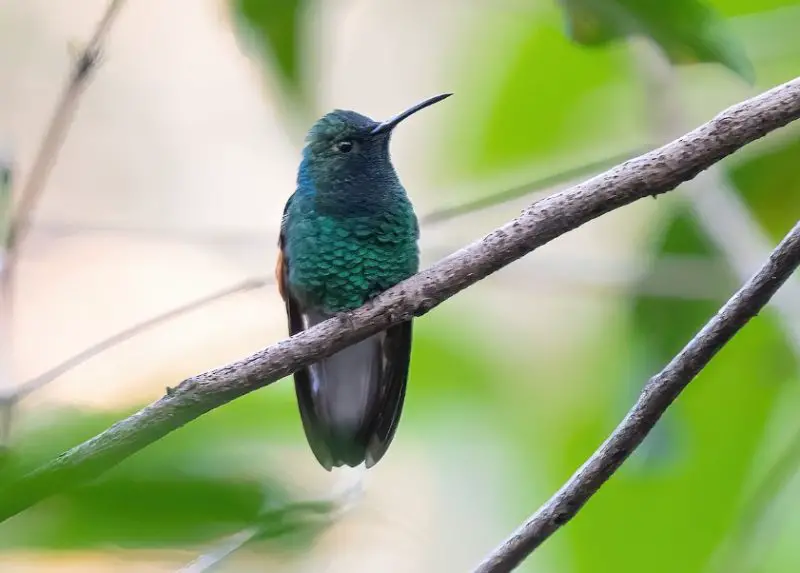
The White-tailed Hummingbird is another rare species occasionally found in Texas, particularly in the western mountainous regions during migration. It is slightly larger than some other hummingbirds, about 4 inches long with a wingspan near 5 inches. Males have iridescent green upperparts, a white tail with black tips, and a brilliant red throat patch that glimmers in sunlight. Females are paler with green backs and white underparts, lacking the male’s bright throat coloration. Their moderately long bills are slightly curved, specialized for deep flowers.
White-tailed Hummingbirds typically inhabit pine-oak woodlands and mountainous terrain, feeding on a variety of native wildflowers. In Texas, they are most often observed in late spring and early summer as they migrate between breeding areas further west and wintering grounds in Mexico. Their feeding habits include frequent visits to nectar-rich flowers and catching insects on the wing for additional protein.
A fun fact about the White-tailed Hummingbird is its unique tail pattern, which helps distinguish it from other similar species during quick flight. Their presence in Texas is considered a special treat, as these birds are seldom seen so far east of their usual range.
Broad-billed Hummingbird
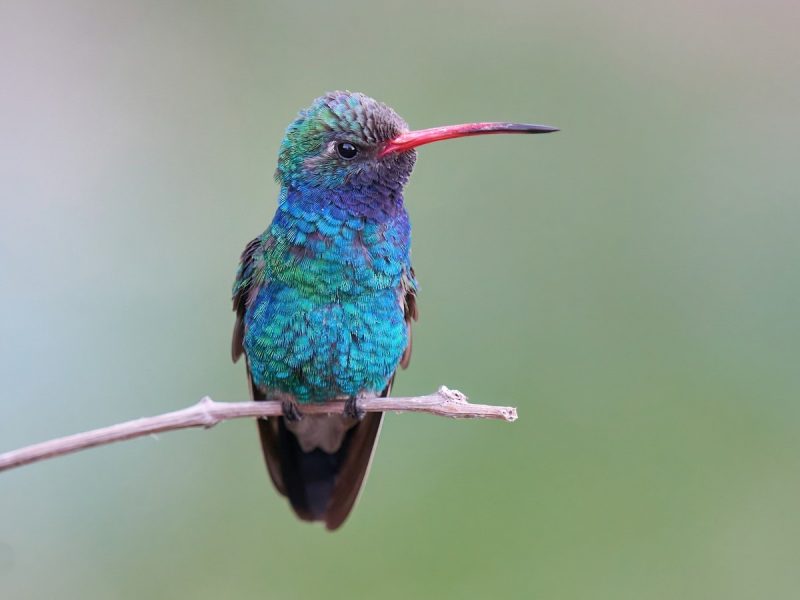
The Broad-billed Hummingbird is a vibrant species most commonly found in southwestern Texas, especially near the Rio Grande and in the Davis Mountains. Males are striking with bright turquoise-blue throats, metallic green bodies, and bright red bills tipped in black, while females are less colorful, featuring greenish upperparts and pale underparts with reddish bills. Adults measure about 3.5 to 4 inches long with a wingspan close to 4.75 inches, giving them a medium size compared to other hummingbirds in the state.
This hummingbird prefers riparian woodlands, desert washes, and gardens where native flowers abound. In Texas, they feed actively on nectar and small insects, showing bold behavior by defending feeding territories aggressively. Their courtship involves rapid shuttle flights and displays that flash their brilliant throat and body colors. Broad-billed Hummingbirds are known for their adaptability to various semi-arid habitats and are a favorite among birdwatchers for their vivid appearance.
A fun fact about the Broad-billed Hummingbird is that it can regulate its body temperature efficiently, allowing it to thrive in both hot desert conditions and cooler mountain areas. Their striking colors and willingness to visit feeders make them a delight to observe in Texas’s western regions.
Violet-crowned Hummingbird

The Violet-crowned Hummingbird is a striking species occasionally seen in southern Texas, particularly around the Rio Grande Valley. It is recognizable by its bright white underparts, metallic green back, and a vivid violet-blue crown that shimmers in sunlight. Adults are about 4 inches long with a wingspan of around 4.7 inches, making them one of the larger hummingbirds in the region. Their long, slightly curved bills enable efficient feeding on tubular flowers.
They prefer arid scrub and canyon habitats with abundant native flowering plants such as agave and desert honeysuckle. During spring and summer, they actively feed on nectar while supplementing their diet with insects. Males perform aerial displays to attract mates, flashing their iridescent crown feathers during flight.
A fun fact is that the Violet-crowned Hummingbird is less tolerant of disturbed habitats than other hummingbirds, often favoring remote, natural areas. This makes sightings in Texas particularly special for birdwatchers, as these birds are more elusive and less frequently encountered.
Lucifer Hummingbird
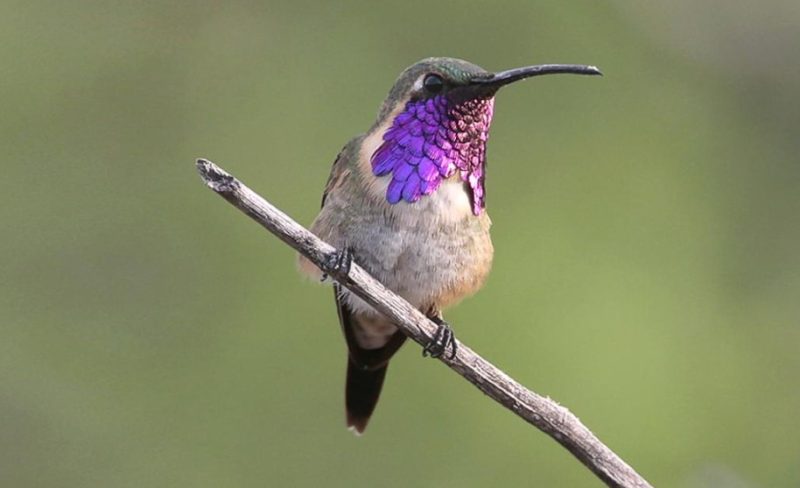
The Lucifer Hummingbird is a rare and fascinating visitor to western Texas, particularly in the Big Bend region. It is notable for its curved bill, long forked tail, and brilliant magenta throat patch on males that shines vividly in sunlight. Females have more subdued green and white plumage with a slightly decurved bill. Adults measure about 3.5 to 4 inches in length with a wingspan near 4.5 inches.
These hummingbirds inhabit desert canyons and slopes, feeding on nectar from plants like agaves and ocotillo. Males often perch in exposed locations, performing territorial displays and chasing off rivals. Their feeding strategy includes quick flights between flowers and agile insect-catching midair.
A fun fact about the Lucifer Hummingbird is that its name derives from Latin for “light-bearer,” a nod to the male’s glowing throat feathers. Due to its limited range and secretive habits, it is a prized sighting for Texas birdwatchers exploring desert habitats.
Violet-headed Hummingbird
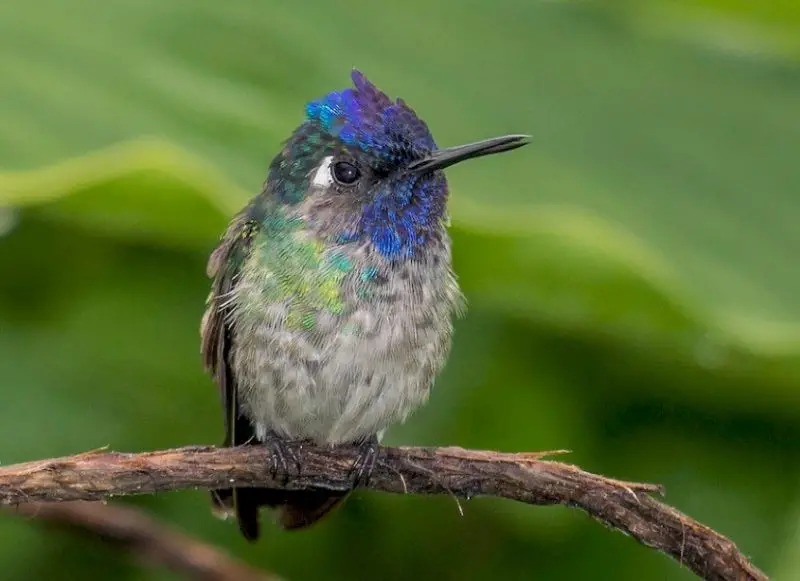
The Violet-headed Hummingbird is a rare visitor to Texas, mainly seen during migration in the southern parts of the state. It measures about 3.5 inches long and is easily identified by its brilliant violet head, green back, and pale underparts. Males have a striking iridescent violet crown that shines vividly in sunlight, while females are duller but retain some violet on the head.
This species typically inhabits tropical forests and woodland edges, feeding on nectar from a variety of flowers and small insects. In Texas, sightings are rare and usually happen during unusual migration events. They are fast, agile flyers that often hover near brightly colored blooms.
A fun fact about the Violet-headed Hummingbird is that despite its rarity in the U.S., it is fairly common in its Central and South American range, where it plays an important role in pollinating native plants.
Berylline Hummingbird
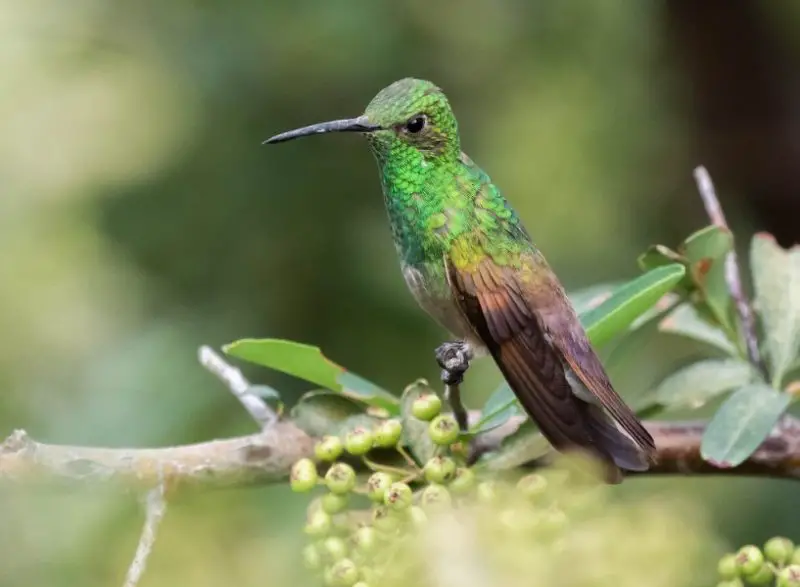
The Berylline Hummingbird is another uncommon but documented visitor to Texas, especially in the southwestern regions. It is medium-sized, about 3.5 to 4 inches in length, with a striking emerald-green body and a slightly curved black bill. Unlike many other hummingbirds, the Berylline shows less sexual dimorphism; both males and females have similar coloring, though males may display a brighter green throat.
This hummingbird prefers scrubby woodland and thorn forest habitats, feeding on nectar from a wide variety of flowers as well as small insects. In Texas, it is most often seen during migration or dispersal from its usual range in Mexico.
A fun fact about the Berylline Hummingbird is that it is known for its calm and less aggressive nature compared to other territorial hummingbirds, often feeding peacefully alongside other species.
FAQs About Hummingbirds in Texas
What are the most common hummingbird species found in Texas?
The most common hummingbird species in Texas include the Ruby-throated Hummingbird, Black-chinned Hummingbird, Anna’s Hummingbird, Rufous Hummingbird, and Broad-tailed Hummingbird. These species are frequently seen across different parts of the state, depending on the season and habitat.
When is the best time to see hummingbirds in Texas?
Hummingbirds are most abundant in Texas during spring and summer months, especially from March through September. This period aligns with their breeding and migration seasons, offering the best chances to observe a variety of species.
Do hummingbirds migrate through Texas?
Yes, many hummingbird species migrate through Texas during spring and fall. Texas serves as an important stopover for these tiny birds, providing nectar sources and resting spots on their long journeys between breeding grounds in North America and wintering areas in Mexico and Central America.
What kind of habitat do hummingbirds prefer in Texas?
Hummingbirds in Texas prefer habitats with abundant flowering plants such as gardens, woodlands, scrublands, and riparian areas. They are attracted to native flowers that produce high amounts of nectar, as well as feeders stocked with sugar water.
How can I attract hummingbirds to my garden in Texas?
To attract hummingbirds, plant native nectar-rich flowers like trumpet vine, bee balm, and salvia. Using hummingbird feeders filled with fresh sugar water (four parts water to one part sugar) without any red dye can also help. Avoid pesticides and provide fresh water sources for drinking and bathing.
Are hummingbirds aggressive toward each other?
Yes, many hummingbird species can be territorial and aggressive, especially males during breeding season. They often chase away other hummingbirds from feeders or flower patches to defend their feeding territory.
What do hummingbirds eat besides nectar?
Besides nectar, hummingbirds consume small insects and spiders, which provide essential proteins and nutrients. They catch insects midair or pick them from plants and spider webs.
How fast do hummingbirds flap their wings?
Hummingbirds can flap their wings incredibly fast, typically around 50 to 80 beats per second depending on the species. This rapid wing movement allows them to hover precisely and maneuver swiftly in the air.


